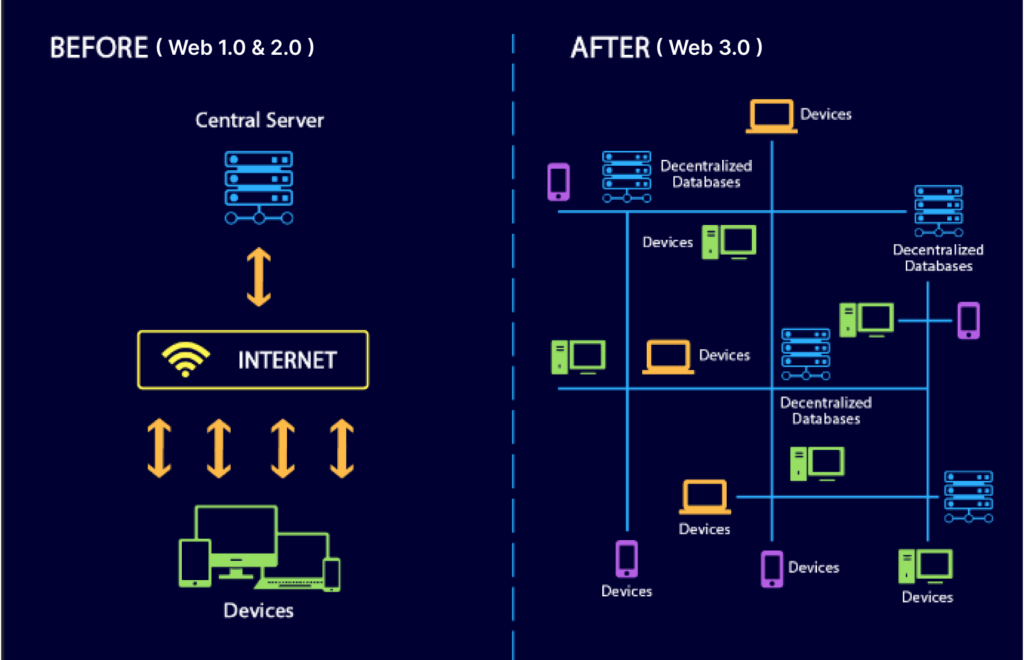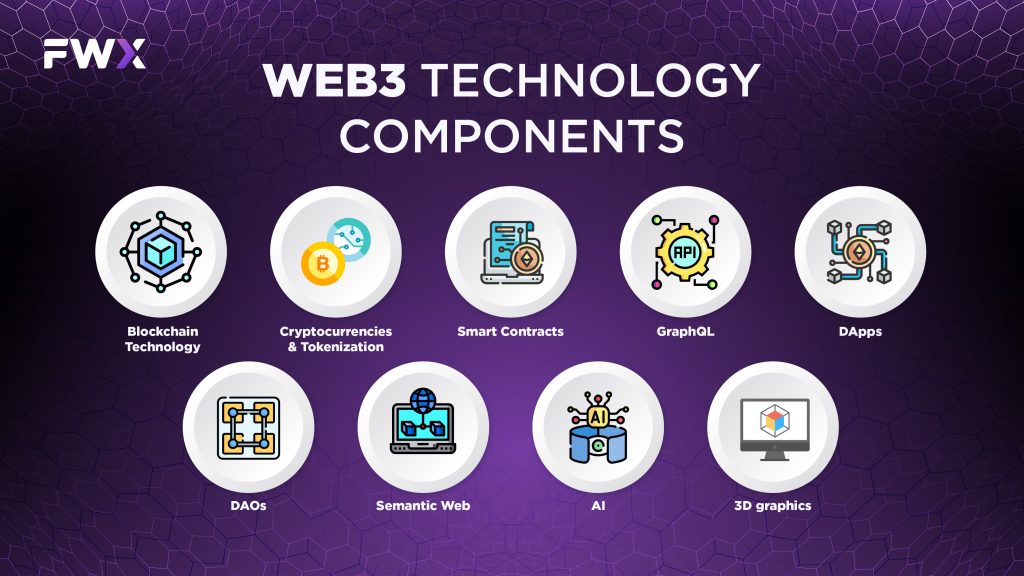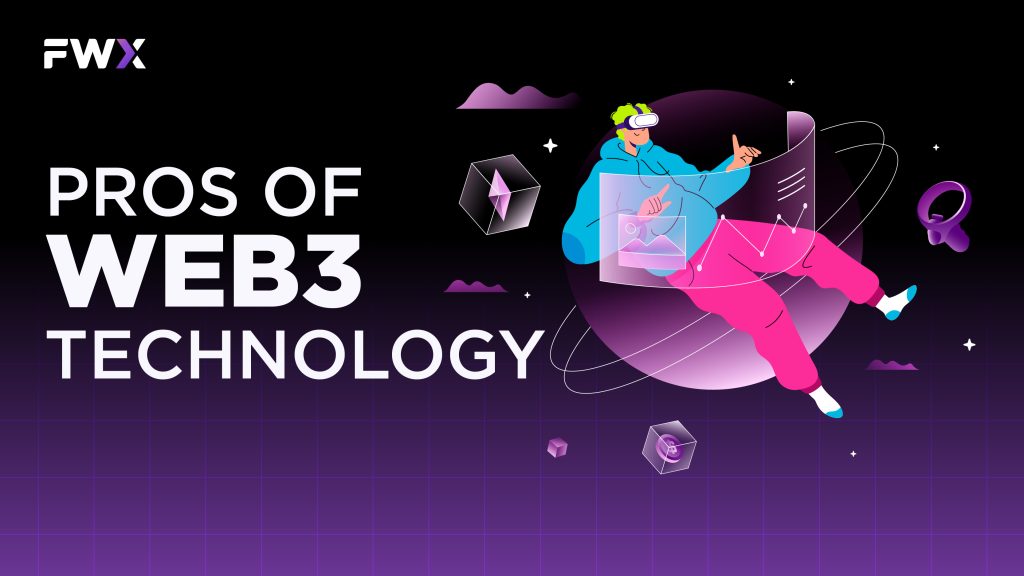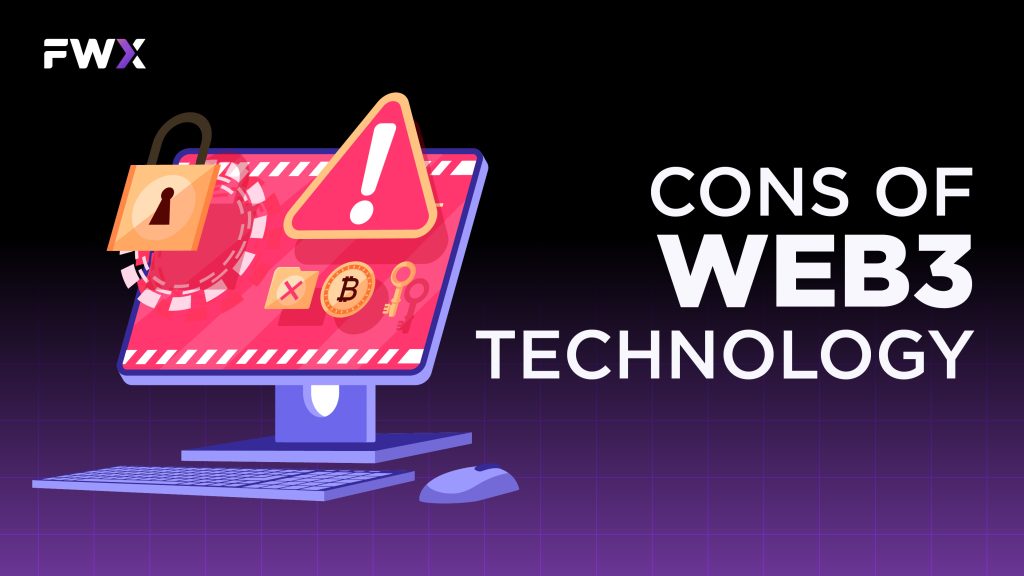The internet has undergone a remarkable transformation since its humble beginnings. From the static pages of Web 1.0 to the interactive platforms of Web 2.0, we’ve witnessed a constant evolution driven by innovation and changing user needs. Now, on the horizon, emerges Web3, a vision for a decentralized, user-controlled internet built on the foundation of blockchain technology and other cutting-edge tools.
This article delves into the intricacies of Web3, exploring its core components, potential benefits and drawbacks, and paving the way for a deeper understanding of this transformative technology.
What is Web3 technology?

Web3 technology refers to a vision of the next evolution of the World Wide Web, emphasizing decentralization, increased user control, and enhanced security. It represents a paradigm shift from the current centralized internet model to a more distributed and user-centric approach. Web3 incorporates various technologies and concepts, including blockchain, cryptocurrencies, decentralized applications (DApps), smart contracts, and more, to create a more transparent, inclusive, and secure digital ecosystem. The goal is to move away from reliance on central authorities and intermediaries, enabling users to have greater ownership of their data and online experiences. Web3 is a broad and evolving concept that aims to redefine the way we interact with and experience the internet.

Source: https://www.educative.io/answers/what-is-web-30
Components of Web3 technology

Web3, the next evolutionary stage of the internet, promises a tectonic shift in how we interact, transact, and own things online. This shift is powered by a complex interplay of technologies, each playing a crucial role in building a more open, transparent, and user-centric digital landscape. Let’s delve into the core components that are shaping the Web3 revolution:
Blockchain Technology
The bedrock of Web3, blockchain is a distributed ledger that records transactions and data securely across a network of computers. This decentralization eliminates the need for centralized intermediaries, fostering trust and transparency. Imagine a shared record book, accessible to everyone but tamper-proof, where every transaction is permanently logged and verifiable.
Cryptocurrencies and Tokenization
Cryptocurrencies like Bitcoin and Ethereum are digital assets native to the blockchain. They facilitate secure and borderless transactions, but Web3 goes beyond just currency. Tokenization allows for the creation of digital tokens representing anything from virtual assets to real-world objects, unlocking new avenues for ownership and value exchange.
Smart Contracts
These self-executing contracts written in code reside on the blockchain. They automate agreements and transactions based on pre-defined conditions, eliminating the need for trust in intermediaries. Think of them as self-driving agreements, ensuring fairness and transparency in every interaction.
GraphQL
This query language streamlines data access in Web3 applications. It allows users to request specific data from various sources, piecing together a customized experience without needing to download everything at once. Think of it as a personalized information butler, fetching only what you need, when you need it.
Decentralized Applications
These applications run on decentralized networks, free from the control of any single entity. dApps empower users to own and control their data, while fostering open-source development and community governance. Imagine a web application where you, the user, are not just a customer, but an active participant in its evolution.
Decentralized autonomous organizations
DAOs are internet-native organizations governed by their members through smart contracts and community voting. This eliminates the need for traditional hierarchies and empowers individuals to collectively manage resources and make decisions. Think of it as a community-run venture, where every member has a say and the rules are written in code, not on paper.
Semantic Web
This next generation of the web aims to understand the meaning of data, not just its syntax. By enriching data with semantic tags and relationships, Web3 applications can provide more relevant and personalized experiences, paving the way for truly intelligent interactions. Imagine a web that understands your preferences and anticipates your needs, not just displaying information, but interpreting it for you.
Artificial Intelligence
AI plays a crucial role in Web3, powering everything from data analysis and machine learning to personalized recommendations and fraud detection. As Web3 applications become more complex, AI will be essential in ensuring their smooth operation and user-friendliness. Imagine an AI assistant that helps you navigate the Web3 landscape, making informed decisions and streamlining your interactions.
3D graphics
Web3 is not just about data and code; it’s about building immersive experiences. 3D graphics and virtual reality technologies are finding their way into Web3, creating interactive and engaging environments that blur the lines between the digital and physical worlds. Imagine a metaverse where you can own virtual land, attend concerts, and interact with others in a whole new dimension.
These are just a glimpse of the many components that are shaping the future of Web3. As these technologies evolve and converge, we can expect a digital landscape that is more open, secure, and user-centric than ever before.
Pros of Web3 Technology

Web3, the next iteration of the internet, promises a paradigm shift in how we interact, transact, and own things online. It’s a vision built on a foundation of cutting-edge technologies, each contributing to a more open, secure, and user-centric digital landscape. Let’s delve into the pros of Web3 technology that are paving the way for this exciting future:
- Decentralization: The cornerstone of Web3, decentralization eliminates the need for centralized intermediaries, empowering users with greater control over their data and online experiences. Imagine a web where you’re not just a consumer, but an active participant, owning your data and contributing to the evolution of the platform.
- Enhanced Security and Privacy: Web3 leverages blockchain technology, renowned for its cryptographic security and tamper-proof nature. This translates to more secure transactions, better privacy protection, and reduced vulnerability to data breaches. Think of it as a fortified digital fortress, safeguarding your online identity and assets.
- Transparency and Trust: With all transactions and data publicly visible on blockchains, Web3 fosters transparency and accountability. This builds trust between users and platforms, paving the way for more ethical and collaborative online interactions. Imagine a web where every action is traceable and verifiable, promoting fairness and responsible behavior.
- User Ownership and Control: Web3 empowers users to truly own their digital assets, be it data, virtual land, or even in-game items. This ownership comes with the freedom to use, trade, or sell these assets as they see fit, unlocking new avenues for economic participation and wealth creation. Imagine a web where you’re not just a tenant, but a homeowner, building your own digital estate and reaping the benefits.
- Democratization and Access: Web3 breaks down barriers to entry, making the internet more accessible and inclusive. Open-source protocols and decentralized platforms allow anyone, regardless of location or background, to participate in the digital economy and contribute to the development of online communities. Imagine a web where everyone has a voice and equal opportunity to thrive online.
- Innovation and Experimentation: The open and permissionless nature of Web3 fosters a vibrant ecosystem for innovation and experimentation. Developers can build new applications and services without needing approval from gatekeepers, leading to a faster pace of development and a wider range of possibilities. Imagine a web where creativity knows no bounds and new ideas can flourish without restriction.
- Community-driven Governance: Web3 empowers communities to govern themselves through decentralized autonomous organizations (DAOs). These internet-native organizations operate on pre-defined rules encoded in smart contracts, fostering collective decision-making and shared responsibility. Imagine a web where communities, not corporations, hold the reins, shaping their online spaces according to their shared values and goals.
- Interoperability and Collaboration: Web3 applications are designed to be interoperable, meaning they can seamlessly interact with each other and share data. This fosters collaboration and synergy across platforms, creating a more interconnected and unified digital landscape. Imagine a web where your online experiences flow seamlessly between different platforms, enriching your digital life in new ways.
- Sustainable and Responsible Future: Web3 technologies like blockchain can be used to track and manage resources efficiently, promoting sustainability and environmental responsibility. Additionally, decentralized governance models can incentivize ethical behavior and hold actors accountable for their actions. Imagine a web that not only benefits us but also contributes to a greener and more equitable future.
These are just some of the many pros of Web3 technology. While still in its early stages, Web3 holds immense potential to reshape the internet for the better.
Cons of Web3 Technology

While Web3 promises a utopian future of a decentralized, user-controlled internet, it’s not without its potential drawbacks. Like any nascent technology, it’s crucial to acknowledge and address these challenges to ensure responsible development and avoid unforeseen pitfalls. Here’s a glimpse into the potential cons of Web3 technology:
- Complexity and Accessibility: Web3 relies on complex technologies like blockchain and cryptography. Navigating these can be daunting for the average user, potentially excluding those less tech-savvy from fully participating in the Web3 revolution.
- Security and Scalability: While blockchain boasts robust security, it can be susceptible to certain vulnerabilities like hacks and exploits. Additionally, scaling blockchain-based applications to handle large volumes of users and transactions remains a challenge, potentially hindering widespread adoption.
- Environmental Impact: Crypto mining, a key component of some blockchains, can be energy-intensive, raising concerns about its environmental footprint. Balancing decentralization with energy efficiency is crucial to ensure Web3 doesn’t come at the cost of a strained planet.
- Regulatory Uncertainty: The decentralized nature of Web3 presents challenges for traditional regulatory frameworks. This lack of clear oversight might attract malicious actors and hinder mainstream adoption due to concerns about financial crime and consumer protection.
- Social and Economic Inequality: While Web3 aims to democratize the internet, it also carries the risk of exacerbating existing inequalities. Access to technology and financial resources remains uneven, potentially creating a digital divide where only certain groups reap the benefits of Web3.
- Potential for Manipulation and Misinformation: Decentralization can be a double-edged sword. While it empowers users, it also allows for the spread of misinformation and manipulation. Echo chambers and filter bubbles might become more pronounced, hindering the free flow of information and critical thinking.
- Unforeseen Consequences: The rapid development of Web3 technologies carries the risk of unforeseen consequences. Ethical considerations and potential long-term impacts need careful evaluation to ensure Web3 truly benefits everyone and doesn’t create unforeseen problems.
It’s important to remember that these are potential cons of Web3 technology, not inevitable outcomes. By acknowledging these challenges and working collaboratively to address them, we can shape the future of Web3 into one that is inclusive, sustainable, and beneficial for all.
In conclusion, Web3 stands as a beacon of hope for a more user-centric, equitable, and secure internet. While challenges remain, the potential of this decentralized revolution is undeniable. As we harness its innovative components and embrace a spirit of openness and collaboration, Web3 can empower individuals, unlock new economic models, and pave the way for a brighter digital future for all.


